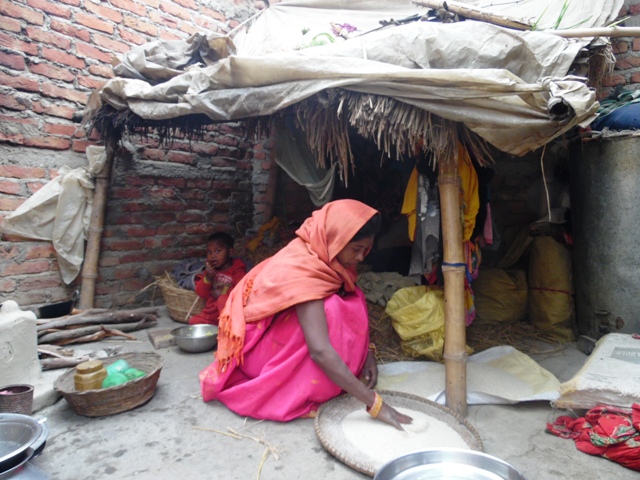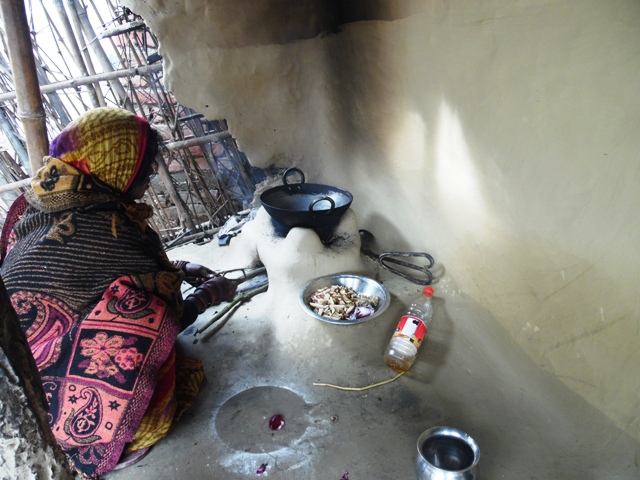
COVID19
Perspectives
5 MIN READ

The Musahar community has long been marginalized and discriminated against, but the Covid-19 pandemic only made things worse.

Fifty-two-year-old Chhathu Majhi of Bihar’s Bhitta village arrives in Khaira of Jaleshwor Municipality, Mahottari, at 6 am in the morning. Along with many other men and women from the Musahar community, Majhi travels to Mahendra Chowk in Jaleshwor, also known as Labor Chowk, where they look for daily wage work. At the end of the day, they walk the two kilometers back home across the border.
On the Nepal-India border in Mahottari, Khaira lies on the Nepal side while Bhitta is on Indian territory. The Musahar community, which shares families and relatives, resides in both these villages. It is common for Indian Musahars to enter Nepal in search of work and for Nepalis to do the same in India due to the open border between the two countries.
The population of the Musahar community in Nepal and in the Indian state of Bihar is about two-and-a-half million. In Nepal’s Tarai, Chamars make up the largest Dalit population, followed by Musahars and then by Dusad/Paswan. Despite the size of their population, Musahars remain one of the most marginalized communities in both India and Nepal. According to a report by ILO, Dalits and Labor in Nepal: Discrimination and Forced Labor, among Tarai Dalits, Musahars rank third-to-last in the social hierarchy, followed by Halkhor and Dom. The highest in the Tarai Dalit caste hierarchy are Dusadh (Paswan), followed by Tatma, Khatwe, Dhobi, Chamar, Batara, and Parmadiya.
In the 2011 census, Musahars were the second to last in terms of literacy with a rate of just around 20 percent, after the Dom community. A vast majority of the community is landless and they are still victims of untouchability and ethnic discrimination, according to Sijendra Sada, a Musahar activist. Their name itself, Musahar or eater of rats, alludes to their position within society.
According to Pramod Sada, an activist from Nepal's Siraha district, Musahars continue to face discrimination in daily life, including untouchability as Dalits. Their plights are often ignored by so-called ‘upper castes’ when seeking justice for ethnic and other forms of discrimination.
For instance, in the village of Madhwa in Mahottari districts, a consumer committee was to be formed to connect pipes for drinking water. Despite the drinking water affecting mostly Musahar community members, a Brahmin man was made chairman of the community. Even now, Musahars are not able to demand rights, says social activist Suresh Thakur.

Across the border in India, things are marginally better for Musahars. Although they still face discrimination, they have been able to acquire assistance from the state government. In Nepal, Musahars face difficulty even obtaining citizenship cards.
Still, Musahars remain politically marginalized in both India and Nepal. In India, one in every four positions in village gram panchayats is reserved for Harijans, i.e., Dalits. Despite such an arrangement, it is difficult to find Musahar mukhiyas or sarpanchs. In the 2021 gram panchayat elections, out of 8,072 mukhiya and sarpanchs, 91 and 1,342 posts were reserved for Dalits and Scheduled Castes. But the number of those who have won these positions from the Musahar caste is negligible.
Even in Nepal, the political situation of Musahars is no different. It is difficult to find any rural municipality chief or deputy chief from the Musahar community. In the local level elections held in 2017, only six Dalits were elected as mayors and 11 as deputy mayors, according to Samata Foundation. Despite Dalits making up more than 13 percent of the population, only 19 of the 275 members of the House of Representatives are Dalits. The proportion of Musahars among these is negligible.
The Mushar community primarily mainly works in agriculture. But a decline in agricultural work in Nepal and Bihar has led them to migrate elsewhere for work. Despite facing problems in education, health, employment, and access to justice, Nepali Musahars have begun migrating to Qatar, Malaysia, and Saudi Arabia for employment. But most Musahars are still employed in Haryana and Punjab in India, where they work as agricultural laborers. Musahar children too work in the labor markets of Delhi, Mumbai, Chennai, and Calcutta. Similarly, many Indian Musahars come to Nepal for work, finding jobs as daily wage laborers and in brick factories.
Unfortunately, the Covid-19 pandemic has pushed Musahars even further into the margins. Untouchability and caste discrimination continued against members of the Dalit community, especially Musahars, in government quarantine. In 2020, during the lockdown, Malar Sada of Saptari died of hunger. Even though food materials were distributed through the ward office, it did not reach many Musahars and even when it did, it was spent within a week.
READ MORE: The game of double attack against Dalits
Dalit communities have been demanding cash assistance or concessional loans from the government but these voices have not been heard. Many Dalits died not only from starvation but also from a lack of cash for medical treatment. Raju Sada died in isolation after not receiving medication for diarrhea.

According to a report by Samata Foundation on the impact of Covid-19 on the Dalit community, out of 1,500 Dalit respondents from across the country, 82 percent reported financial difficulties and 45 percent lost their jobs. Fifty-two percent said that they faced a food crisis. Although disaggregated data is unavailable, it is likely that Musahars were affected disproportionately in these instances too.
During the pandemic in Bihar, food rations were provided to Scheduled Castes and the poor. During the lockdown period, Rs 1,000 was deposited in their bank account on behalf of the government. Nepali Dalits did not receive any such targeted benefits, despite being much more at risk.
Given that the Musahar community in both India and Nepal face similar problems, a joint action plan from both the countries would ultimately benefit them. Local governments, especially in Nepal’s Province 2 and India’s Bihar, need to work together on literacy, health, land, and housing for the Musahar community.

Explainers
Longreads
10 min read
Comrade Netra Bikram Chand ‘Biplab’ and Prime Minister Oli are both in difficult positions and they are both looking for a way out.
Features
11 min read
The commission’s recently published list of rights abusers who remain unpunished shines a light on the culture of impunity that has plagued the country for far too long
COVID19
News
3 min read
A daily summary of Covid19 related developments that matter
COVID19
Features
7 min read
The coronavirus pandemic has become yet another excuse for the government to delay long-overdue investigations into war-era crimes
COVID19
Photo Essays
7 min read
When Nur Bahadur Thapa died of an accident in Riyadh, his body was repatriated by his friend, driven
COVID19
News
3 min read
A daily summary of Covid19 related developments that matter
COVID19
News
3 min read
A daily summary of Covid19-related developments that matter
Features
COVID19
5 min read
After suffering injustice for years, the farmers have finally descended on Kathmandu to press their demands